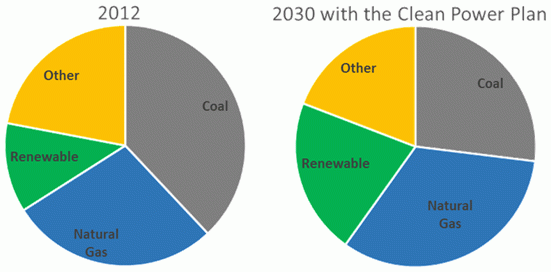On August 3, 2015, President Obama and EPA announced the Clean Power Plan – a historic and important step in reducing carbon pollution from power plants that takes real action on climate change. Shaped by years of unprecedented outreach and public engagement, the final Clean Power Plan is fair, flexible and designed to strengthen the fast-growing trend toward cleaner and lower-polluting American energy. With strong but achievable standards for power plants, and customized goals for states to cut the carbon pollution that is driving climate change, the Clean Power Plan provides national consistency, accountability and a level playing field while reflecting each state’s energy mix. It also shows the world that the United States is committed to leading global efforts to address climate change.
Clean Energy is Happening Now
- Environmental protection isn’t a luxury; it’s the foundation of healthy lives and strong economies, which go hand in hand. A modern economy needs a modern energy system and a clean environment.
- The Clean Power Plan doesn’t reinvent the wheel—it builds on the progress that states, cities and businesses have been making for years.
- It allows planning, investment and reductions to begin now, with the period for mandatory reductions beginning in 2022, giving states and utilities the flexibility they need to build on the transition to clean energy already under way in the power sector.
- Additionally, the Clean Energy Incentive Program rewards early investments in renewable energy generation and demand-side energy efficiency measures that generate carbon-free MWh or reduce end-use energy demand during 2020 and/or 2021.
- States can turn to proven, cost-effective energy efficiency strategies, including those through EPA’s ENERGY STAR program, to help meet their CPP targets.
- EPA also will provide communities and states information on how to access existing financial and technical assistance programs that can help communities increase use of energy efficiency and renewable energy programs. These include federal programs and resources, such as:
- The National Community Solar Partnership, which the White House announced last month, to increase access to solar for all Americans, particularly low- and moderate- income communities.
- The Clean Energy Impact Investment Center, which the Department of Energy will launch to make information about energy and climate programs at DOE and other government agencies accessible and more understandable to the public.
- In addition, the Administration’s POWER+ Plan will invest in workers and jobs, address important legacy costs in coal country and drive the development of coal technology as our country moves to a clean energy economy.
- States, cities and businesses are leading the way with innovative programs and approaches that are increasing renewable energy and energy efficiency.
- These programs provide a head start in meeting the Clean Power Plan’s goals.
- 50 states with demand-side energy efficiency programs
- 37 states with renewable portfolio standards or goals
- 10 states with market-based greenhouse gas reduction programs
- 25 states with energy efficiency standards or goals
- Investments in renewable technologies are already paying off.
- The United States uses three times more wind energy than it did in 2009.
- Last year, the United States brought online as much solar energy every three weeks as it did in all of 2008.
- The solar industry added jobs 10 times faster than the rest of the economy with one job added every 20 minutes.
- Since the beginning of 2010, the average cost of a solar electric system has dropped by 50 percent.
A Clean Energy Future
- In 2030, the Clean Power Plan will cut harmful carbon pollution from the power sector by 32 percent below 2005 levels in a commonsense and pragmatic way, giving states and utilities both time and flexibility to develop strategies that work for their specific needs and that are essential for clean energy innovation.
- Utilities spend $100 billion a year to generate and distribute electricity; the Clean Power Plan will incentivize further investment in cleaner, more modern and efficient technologies.
- As a result, jobs that increase the energy efficiency of homes, buildings, or equipment are projected to rise.
- Overall air quality in the U.S. is expected to continue to improve between now and 2030, and the Clean Power Plan will add to those air quality benefits through additional reductions in emissions of sulfur dioxide and oxides of nitrogen.
- These improvements come as a result of a range of Clean Air Act actions as well as changes in the economics of the power generation sector.
- The share of generation from zero-emitting renewable energy resources, including hydro-power, wind, and solar is expected to grow from 12% in 2012 to 21% in 2030 under the Clean Power Plan.

Printable version of the fact sheet:
You will need Adobe Reader to view some of the files on this page. See EPA’s About PDF page to learn more.